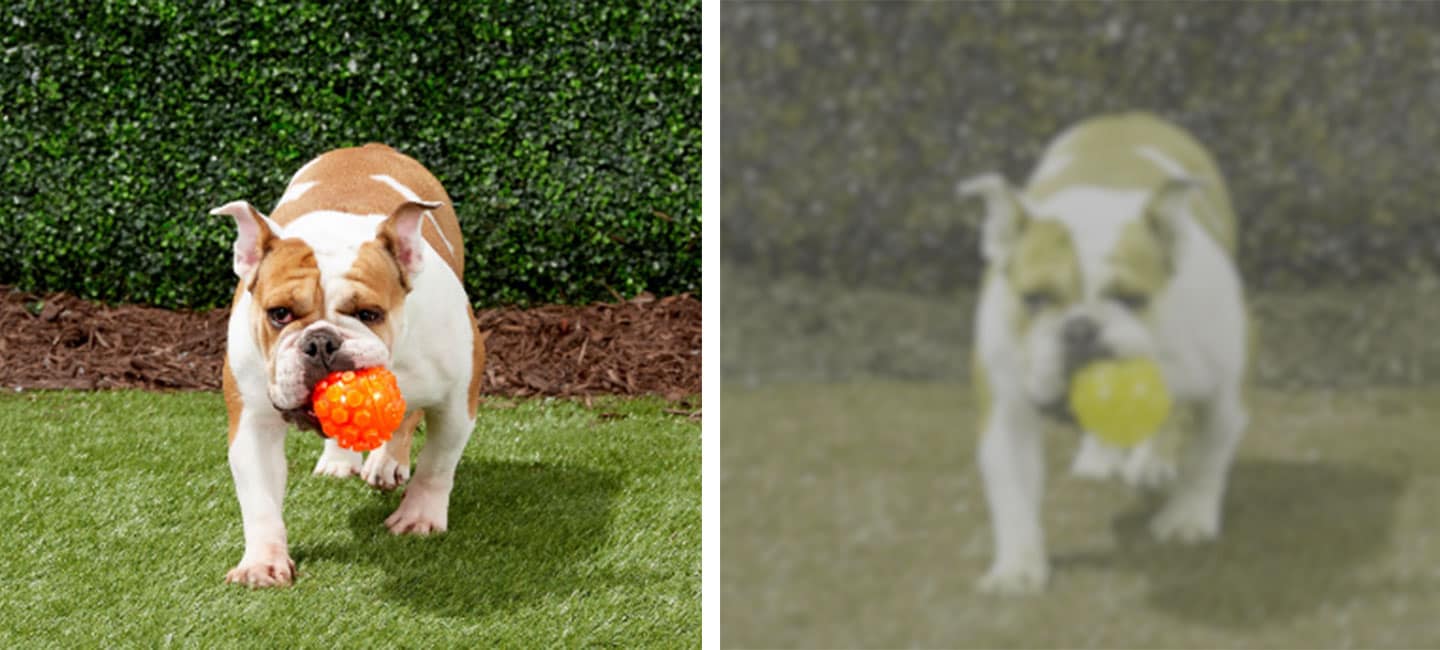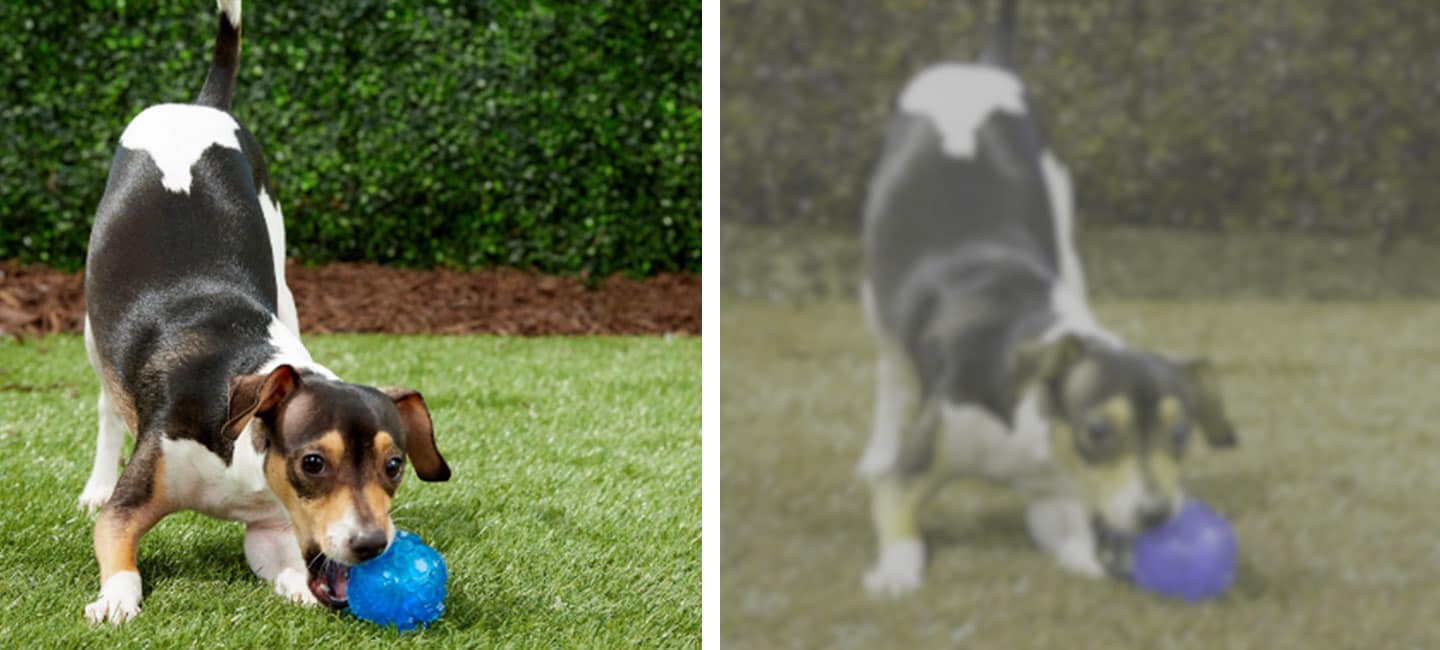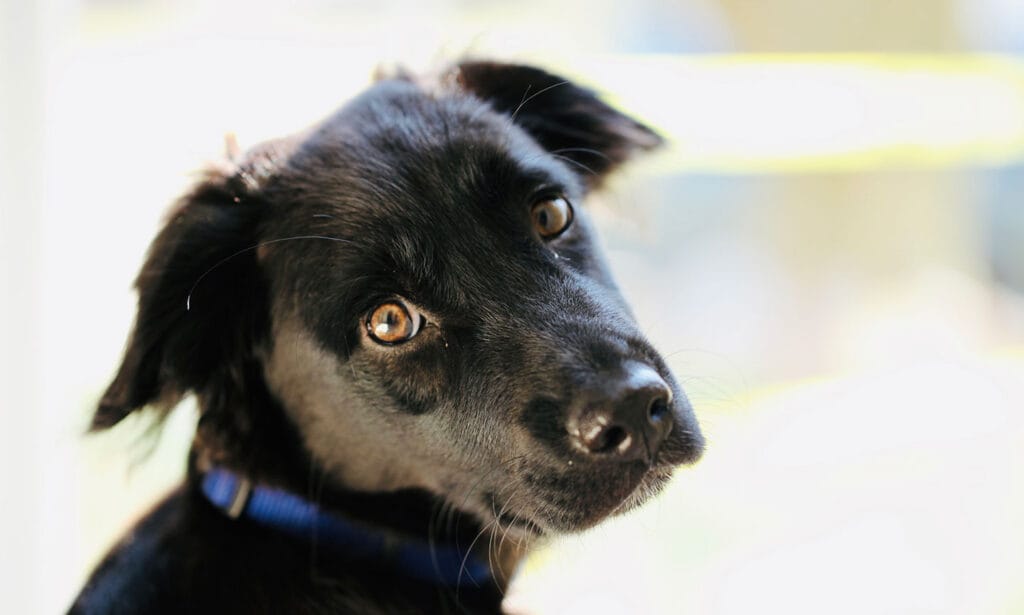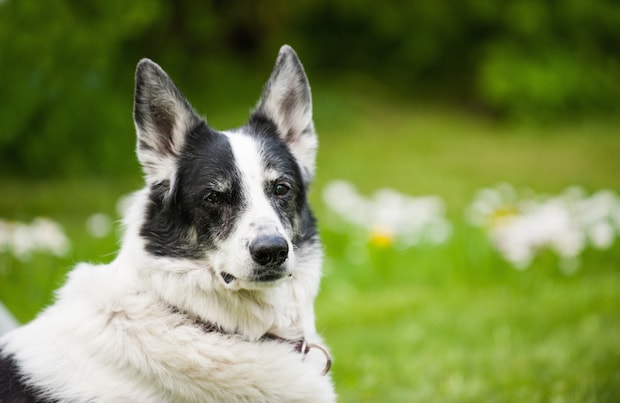Dogs experience the world around them differently than we do. You probably already know they have a superior sense of smell and have more sensitive hearing than humans, but what about their vision? The most common myth about dog vision is that dogs can only see in black and white—and therefore, don’t have any color vision. But that’s actually not true. Because, yes, dogs can see color, just not all the colors of the rainbow.
Can Dogs Actually See Color?
Dogs can, in fact, see color, but it’s a narrower range than most humans can see. That’s because human eyes have three types of cones that help us see and discern color, and a dog’s retina only has two.
“Dogs have dichromatic color vision, which means they have two types of cone photoreceptors within their retina,” explains Dr. Kristin Fischer, DVM, DAVCO, a veterinary ophthalmologist at Animal Eye Care Associates in Mount Pleasant, South Carolina. “This results in a more limited color spectrum visually as compared to humans, [most of whom] have trichromatic vision.”
That dichromatic vision also means that the colors dogs do see are a dimmer version of the brightness we see as humans.
What Colors Can Dogs See?
Dogs can generally detect black and white in terms of dimness. It may not look like the sharp color that humans see, but a dog’s eye can make out the differences in light.
Dogs can also detect yellow and blue, and are able to see different shades of those colors.
However, dogs aren’t really able to see colors like red and green.
“The two types of cones within the canine retina are sensitive to short-wavelength and medium- to long-wavelength light, resulting in perception of the world in shades of blue and yellow, with limited ability to differentiate between red and green,” Dr. Fischer says.
Are Dogs Color Blind?
Because dogs only have two types of cones, the way dogs interpret color is similar to the red-green color blindness that some humans experience.
“[Dogs] are more like a color-blind person who has red and green color blindness, based on the cones in their eyes,” explains Dr. Laurie Hess, DVM, senior exotic animal veterinarian at Chewy and Veterinary Center for Birds & Exotics. While red and green hues are difficult for canine vision, others on the color spectrum—like shades of yellow and blue—appear much more vibrant to a dog’s point of view.
How Dogs See Different Colors
Have you ever wondered what the world looks like through your dog’s eyes? We used this handy-dandy Image Processing Tool to get an accurate interpretation of what dogs see vs. what we see.
Below, you’ll see a pup playing with an orange Frisco Fetch Squeaky Ball. The left side is what humans see visually, and on the right is an approximation of what a dog would see in comparison:

As you can tell, even the green grass gets lost in translation, blurring against the rest of the frame. And here’s the same Frisco Ball toy, only in blue, which stands out more clearly against the grass:

Next up, we ran the pink Frisco Puppy Toy through the same generator. As you can see, on the right hand side, the pink shows up much duller in a dog’s world than it does on the left (aka to humans).

Then, we ran the same Frisco Puppy Toy through the generator, only this time in blue. It very clearly pops against the background much more.

Caring for Your Dog's Eyes
Dr. Fischer recommends the following to protect your dog’s vision:
- Routine veterinary examinations to detect problems early
- Watch for any change in appearance of the eye (redness, cloudiness, discharge) or comfort (squinting, tearing, rubbing)
- Monitor for any changes in vision and have your pet evaluated by your veterinarian or a veterinary ophthalmologist as soon as symptoms are noted
- Good nutrition is also key to promoting long term ocular health
Get more expert advice for how to care for your pet’s eyes by reading up on Facts About Dog and Cat Vision.
What about their environment? If dogs mainly see yellow and blue, should you stick to blue and yellow toys?
“Dogs are used to having dichromatic vision with limited color variability, and therefore no modifications are necessary in your environment to help them see,” Dr. Fischer says. “You can certainly continue to buy toys in all shapes and sizes, and they will love them!”
Sure, your dog will still appreciate a green Frisbee or a red ball, but if you want to make a further enriching environment based on the colors dogs see best, try these products:
Other Facts About Dog Vision
You now know more about a dog’s color perception, but there is still more to learn about dog vision, from whether different breeds see differently (they do) to how dogs see in low-light conditions (very well).
The Ability to See Color Does Not Differ Among Breeds
Most dog breeds detect color the same. However, other aspects of their vision acuity depend on factors like facial conformation, which can affect vision sharpness and width (similar to peripheral vision).
“In general, most dogs have close-to-perfect refraction or emmetropia,” Dr. Fischer says, which is another way of describing perfect visual function in a healthy eye, “but some dogs have conformational or breed-associated adaptations that affect their vision capabilities.”
For example, while Dr. Fischer mentions that breeds like Border Collies, Doberman Pinschers, and German Shepherds have “excellent visual acuity,” or sharpness and clarity of vision, while the short snouts and prominent bulging eyes of brachycephalic dogs, like French Bulldogs, often narrows their field of vision, says Dr. Fischer.
Dogs See Well in Low Light
Another difference between human vision and dog vision is that dog eyes have significantly more rods. The rods process light and motion, which gives them better visual acuity for seeing in low light or in the dark.
In fact, you may have noticed that your dog’s eyes actually glow in the dark, and that’s because they quite literally have night vision.
“The tapetum, or tapetum lucidum, is a reflective structure found in many animal species that is located beneath the retina within the eye,” Dr. Fischer explains. “It functions to amplify photoreceptor stimulation in the eye, which ultimately enhances low-light vision. It basically acts like a mirror, allowing light to bounce around in the eye and stimulate as many rod photoreceptors as possible to enhance vision.”
Dr. Fischer adds, “It is also responsible for the green or yellow eyeshine you may appreciate when light reflects off the tapetum in animals at night.”
Dogs Excel at Detecting Movement
Those rods are also excellent at detecting movement, which is why dogs sometimes spot things—like squirrels in the distance or even a fly by the window—that humans may not notice.
Share:












